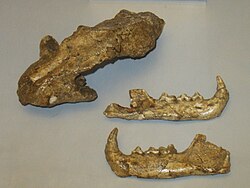Lynx issiodorensis Last updated October 11, 2025 Extinct species of felid
Lynx issiodorensis Issoire lynx , is an extinct species of lynx that inhabited Europe during the Pliocene to Pleistocene epochs , and may have originated in Africa during the Late Pliocene . It is named after the town of Issoire where the first fossilised remains were found. It probably became extinct during the end of the last glacial period . [ 1]
It is generally considered as the ancestor of all four species of lynx alive today. Its skeleton resembled that of living lynxes, but it had shorter and more robust limbs, with a larger head and longer neck. As a result, the Issoire lynx more closely resembled a typical member of the cat family than to its extant descendants.
Taxonomy In 1945, another lynx species, Lynx shansius , was described based on fossils from Asia. However, in 1984 a reexamination of the L. shansius material determined it to be synonymous with L. issiodorensis . [ 2]
References ↑ Sunquist, Mel; Sunquist, Fiona (2002). Wild cats of the World . Chicago: University of Chicago Press . p. 153 . ISBN 0-226-77999-8 1 2 Kurtén, Björn; Werdelin, Lars (1984). "The relationships of Lynx shansius Teilhard" . Annales Zoologici Fennici . 21 (2): 129– 133. Retrieved 24 June 2025 – via JSTOR. ↑ Lacombat, Frédéric; Abbazzi, Laura; Ferretti, Marco P.; Martínez-Navarro, Bienvenido; Moullé, Pierre-Elie; Palombo, Maria-Rita; Rook, Lorenzo; Turner, Alan; Valli, Andrea M.-F. (March 2008). "New data on the Early Villafranchian fauna from Vialette (Haute-Loire, France) based on the collection of the Crozatier Museum (Le Puy-en-Velay, Haute-Loire, France)" . Quaternary International . 179 (1): 64– 71. doi :10.1016/j.quaint.2007.09.005 . Retrieved 24 June 2025 – via Elsevier Science Direct. ↑ Marciszak, Adrian; Wagner, Jan (30 April 2025). "Carnivores from Chlum 4S (Czech Republic): new insight for the latest early Pleistocene carnivore faunas in Central Europe" . Historical Biology : 1– 34. doi :10.1080/08912963.2025.2481528 . ISSN 0891-2963 . Retrieved 6 September 2025 – via Taylor and Francis Online. ↑ Werdelin, Lars; DrăGuşIn, Virgil; Robu, Marius; Petculescu, Alexandru; Popescu, Aurelian; Curran, Sabrina; Terhune, Claire E. (6 September 2023). "Carnivora From the Early Pleistocene of Grăunceanu (Olteț River Valley, Dacian Basin, Romania)" (PDF) . Rivista Italiana di Paleontologia e Stratigrafia . 129 (3). doi :10.54103/2039-4942/20015 . ISSN 2039-4942 . Retrieved 10 October 2025 – via Diva Portal. ↑ Cherin, Marco; Iurino, Dawid A.; Sardella, Raffaele (September 2013). "New well-preserved material of Lynx issiodorensis valdarnensis (Felidae, Mammalia) from the Early Pleistocene of Pantalla (central Italy)" . Bollettino della Società Paleontologica Italiana (2): 103– 111. doi :10.4435/BSPI.2013.16 . ISSN 0375-7633 . Retrieved 25 June 2025 – via IrisAir. ↑ Spassov, Nikolai (30 August 1997). "Varshets and Slivnitsa – new localities of Villafranchian vertebrate fauna from Bulgaria (taxonomic composition, biostratigraphy and climatochronology)" . Geologica Balcanica . 27 (1– 2): 83– 90. doi :10.52321/GeolBalc.27.1-2.83 . Retrieved 7 September 2025 – via Geologica Balcanica. ↑ Koufos, George D.; Grohé, Camille; de Bonis, Louis; Moutrille, Léa; Costeur, Loic; Surault, Jérôme; Kostopoulos, Dimitris S.; Merceron, Gildas (1 July 2025). "Felines from the middle Villafranchian (Early Pleistocene) mammal fauna of Dafnero 3, Greece" . Historical Biology : 1– 20. doi :10.1080/08912963.2025.2524712 . ISSN 0891-2963 . Retrieved 24 July 2025 – via Taylor and Francis Online. ↑ Bukhsianidze, Maia; Koiava, Kakhaber (22 August 2018). "Synopsis of the terrestrial vertebrate faunas from the Middle Kura Basin (Eastern Georgia and Western Azerbaijan, South Caucasus)" . Acta Palaeontologica Polonica . 63 (3). doi :10.4202/app.00499.201 . ISSN 0567-7920 . Retrieved 13 September 2025 – via Acta Palaeontologica Polonica. ↑ Lyubimov, Nikita A.; Iltsevich, Karina Yu; Sablin, Mikhail V. (7 May 2025). "Early Pleistocene Lynx issiodorensis (Croizet & Jobert, 1828) from the Muhkai 2 (northeastern Caucasus, Russia)" . Historical Biology : 1– 9. doi :10.1080/08912963.2025.2501324 . ISSN 0891-2963 . Retrieved 24 June 2025 – via Taylor and Francis Online.
This page is based on this
Wikipedia article Text is available under the
CC BY-SA 4.0 license; additional terms may apply.
Images, videos and audio are available under their respective licenses.
